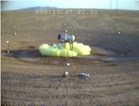Modeling Airborne Chemical Releases: Ninety Tons Of Trouble Blowin' In The Wind

How do DHS experimenters release 4,000 pounds of deadly gas in 1 minute? Very, very carefully.
If you burst a water balloon with a dart, a wall of water will splash down. If you pierce a chlorine rail car with a 50-caliber bullet, a yellow-green gas will gush out, forming a heavier-than-air toxic cloud that could take hours to dissipate as it moves downwind. How wide, far, and fast will it move? What will be the effect on the surrounding area, and how would we begin to contain it? Until recently, answers to questions like these were foggy.
Concerned about a potential toxic catastrophe, the Department of Homeland Security's (DHS) Transportation Security Administration (TSA) launched a research program in 2008, dubbed Project Jack Rabbit, to model large-scale toxic chemical transport releases. Managed by the DHS Science and Technology Directorate's (S&T) Chemical Security Analysis Center (CSAC), the 3-year program aims to determine what would happen if a terrorist burst a chemical tanker filled with a toxic gas, such as chlorine.
Chemists from TSA and S&T have set up a several mile-wide test lab at Dugway Proving Ground, an Army test center nestled deep in the Utah desert. Here, researchers are testing a number of rapid releases to answer critical questions, such as: How would such a massive cloud of chlorine move?
In a single minute, a 500-gallon suspended steel tank released two tons of liquefied chlorine through a 3-inch pipe. The chlorine immediately formed an ominous cloud of deadly gas.
As the cloud drifted, its key characteristics were tracked by a suite of high-tech eyes, ears, noses, and skin stationed near and far. For miles around, equipment had been placed to record the cloud's unpredictable journey, its heading and speed, and temperature changes.
Some of Project Jack Rabbit's potentially life-saving results include:
- Enhanced emergency response procedures. Validated response procedures will be shared in the next national Emergency Response Guidebook for first responders.
- Safer industrial procedures. The Chlorine Institute and the Ammonia Safety and Training Institute are working to update their safety guidelines and training videos.
- Better mitigation strategies. By studying how the gas behaves, TSA hopes to curb potential casualties from a toxic chemical release by positioning barriers or craters near rail yards to trap gas clouds before they leave the incident site.
- Improved defense readiness. Soldiers facing materials poisonous by inhalation, commonly referred to as Toxic Inhalation Hazards (TIH), will be able to better understand what they are facing and be more prepared to respond. In addition, the Department of Defense is exploring ways to protect electronics and vehicles capable of flight against chlorine.
S&T and partners from across the government, academia, and international community joined to study the impacts of the release. Observers from the Office of Health Affairs, the Office of Infrastructure Protection, the Homeland Security Studies and Analysis Institute, TSA, and partners from across the federal government, including the Navy and Air Force, were on hand to study how the cloud would corrode electronics and impact structural aluminum. The Center for Toxicology and Environmental Health also sent emergency response experts and toxicologists to test commercial instruments designed to detect volatile organic compounds, along with other detectors under development by S&T. Together, these groups are working against the clock to find practical solutions to emerging challenges.
SOURCE: U.S. Department of Homeland Security
